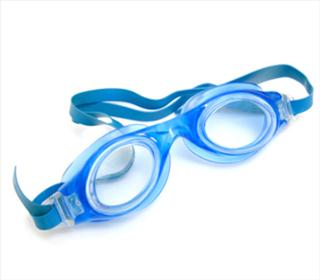How to Choose Prescription Swim Goggles

If you require corrective lenses to see clearly, you may also want to purchase prescription swimming goggles for the pool. Luckily, there are several companies that manufacture prescription goggles in a variety of styles. This guide walks you through how to choose the prescription goggles that are best for you.
The Lens
Prescription goggles come with ready-made spherical lenses of varying strengths known as diopters or step diopters. This type of lens production is similar to the generic reading glasses found in pharmacies: The prescription will be a close match to your own, but may not be as precise as that in the glasses or contact lenses you use every day. For use in the water (an already-blurry environment), step diopter prescription glasses are perfectly adequate. They are also more widely available and affordable than custom-made prescription goggles from a doctor's office.
Negative diopter lenses are the most commonly available goggles and are intended for those with nearsighted or myopic vision. Lenses range in diopters from -1.5 to -10.0 and come in increments of 0.5. Positive diopter lenses are for farsighted swimmers and are less common.
Finding Your Diopter Strength
The first step to choosing prescription swimming goggles is determining the diopter strength that most closely matches your current prescription. Follow the below steps, or ask your doctor to help you choose the best ones for you.
- Get your most current prescription numbers.
- Calculate the strength of the diopter you need using this formula:
1/2 of the cylinder + sphere = diopter strength
Sphere (SPH) is the degree of weakness in diopters. This is always a negative number for nearsighted people and a positive number for farsighted. Cylinder (CYL) is the degree of astigmatism in your eye. Add half of this number to the sphere to determine diopter strength.
- To choose a diopter lens, simply find the one that has a prescription closest to your own. A general rule of thumb when choosing a diopter lens is to round down — rather than up — to the prescription that most closely matches your own. This places less strain on your eyes.
For example, if your prescription is a sphere of -5.0 and a cylinder of +2.0, then (1/2 x +2.0) + -5.0 = -4.0 step diopter lens. Or if your prescription is a sphere: -2.0 and a cylinder: -1.0, then (1/2 x -1.0) + -2.0 = -2.0 (rounded up from -2.5) step diopter lens.
Choose the Goggle Model
Prescription goggles have come a long way in recent years. Prescription goggles users can now choose from lenses and goggle frames that are just as sleek and hydrodynamic as non-prescription goggles.
- There are both recreational and racing styles of prescription goggles. Serious swimmers, triathlon and open water swimmers, and lap swimmers will want to buy a racing style and should look for low-profile frames, or those with "racing" in the model name.
- Racing goggles usually have a range of advanced features to choose from like UV protection, anti-fog coating, and different size nose pieces.
- Swimmers with less swimming experience, or just want an alternative to going without glasses in the water — such as masks or goggles with larger lenses — should look at recreational models. These have more generously padded frames and offer wider peripheral vision.
- Recreational models tend to have fewer features making them a more affordable option for the casual swimmer.
- Some brands (such as Aqua Sphere™) offer separate prescription lenses that can be inserted into specific goggle models. Make doubly sure that the lenses you order are compatible with your goggle frames. This may be a good option for swimmers whose eyes have significantly different prescriptions.
- There are a few brands (such as Sporti™) that design bifocal goggles, with just the lower half of the lens set to a certain prescription.
- A few brands that offer positive diopter lenses are TYR and Sporti.
Optical goggles, also known as prescription goggles may be a bit more expensive than non-prescription goggles, but they are still very affordable (and getting more so every year). If you are having trouble deciding which goggles to buy, consider asking your optometrist. Once you have your goggles, it may take a few minutes for your eyes to adjust to the new lens, but after a short adjustment period, you should be able to use them adequately in the pool.
Two Different Eye Strengths?
No problem! Did you know that you can make a custom pair by buying two sets of goggles? Although this might seem expensive at first -- ultimately, you'll end up with two pairs of goggles perfectly tailored to your unique eye strength.
Simply follow these instructions to swap lenses:
- Choose a pair of goggles to start with.
- By holding the nose bridge and straps, simply pop the silicone or polycarbonate gasket off of the nose bridge using your thumb with gentle force.
- Turn the goggles around, so that you have the straps in hand and undo the straps so you can slide the loose gasket off. Set it aside.
- Now, repeat steps 2 and 3 on the other pair of goggles. NOTE: Make sure not to mix up your left eye and your right eye lenses! Tip: you can use blue painter's tape to label left from right.
- Before you connect the loose gasket to the nose bridge, be sure your left and right lenses are in the appropriate position for your unique prescription.
- Now, with the same gentle force, pop the loose gasket into the nose bridge and repeat on the second pair.
- Last, thread the straps back into place and adjust them to your liking.
